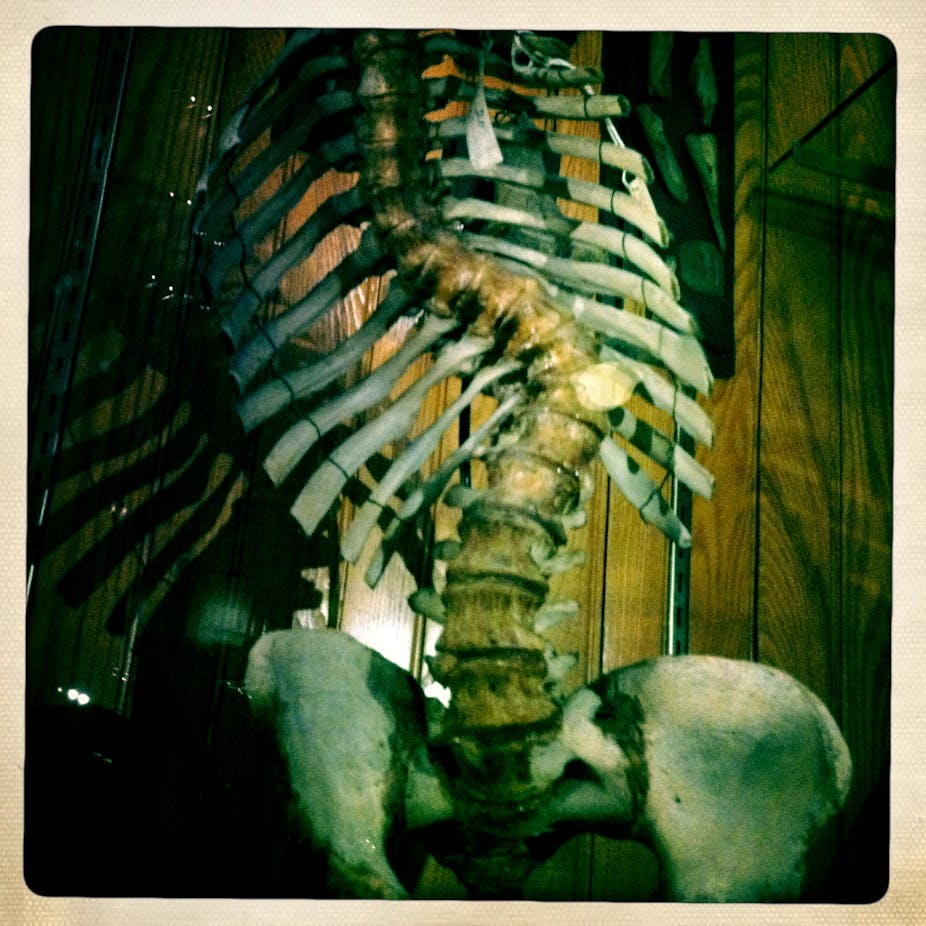Scoliosis can affect children of all ages and can have particularly severe effects when it develops early or in association with another medical condition. If the condition progresses and becomes severe, it can cause pain, make physical activities harder and limit lung capacity.
When humans evolved to walk on two legs, we developed a curve in our lower back to balance our trunk and another in our neck to balance our head, to enable forward vision. But sometimes the spine develops an additional, sideways curve that can’t be fixed by simply sitting up straighter. This is known as scoliosis, a word derived from the Greek “skolios” meaning “curved”.
A scoliosis looks uneven and usually takes one of two shapes. A “C” curve bends to just one side, whereas an “S” curve bends first one way and then the other, so the spine is more balanced overall. One shoulder blade may appear more prominent if the spine also rotates as a result of the scoliosis.
Causes and diagnosis
The condition has many known causes: a structural abnormality in the vertebrae or ribs (congenital scoliosis); in association with a childhood syndrome that has a particular pattern of symptoms and may include scoliosis (syndromic scoliosis); or an underlying nerve or muscle condition that leads to poor control of the muscles of the spine (neuromuscular scoliosis).
Conditions associated with scoliosis include cerebral palsy, genetically caused disorders such as Rett syndrome or one of the neuromuscular disorders such as Duchenne Muscular Dystrophy.
But most scoliosis is “idiopathic”, meaning there’s no known cause for it, although some research suggests a genetic link. Most idiopathic scoliosis occurs in adolescents, especially girls. While not yet wholly understood, it’s commonly estimated that approximately 2% of girls will develop a scoliosis that requires monitoring.
Sometimes, idiopathic scoliosis occurs in children between two and ten years of age (known as juvenile idiopathic scoliosis). This affects boys more than girls. More rarely, idiopathic scoliosis develops in even younger children and a mother is usually able to feel the spinal curve early on when cuddling her baby.
Scoliosis can also develop during adulthood – for example, with arthritis in the spine or sometimes after a spine fracture due to osteoporosis.
The condition usually develops slowly and early symptoms are subtle; the spine may start to look uneven and the child may develop a lean or a limp.

For diagnosis, a forward bending test is used to observe the spine. If one side of the rib cage lifts while the child is bent, then he or she is likely to have scoliosis. When doctors suspect scoliosis is developing, they will request an X-ray of the spine and measure the curve.
Impacts and interventions
A small curve is not very noticeable and will most likely have little impact on health. A curve that progresses into a more severe shape can have serious health impacts. It can cause pain, make sitting and walking more difficult and eventually affect respiratory capacity as the lungs have less room to expand.
Screening programs are conducted in only a few countries, including parts of the United States. In other countries like Australia, such programs no longer used for adolescent idiopathic scoliosis, but girls in secondary schools are given a self-detection brochure for families to check their spines. If scoliosis is detected, consultation with a general practitioner is recommended.
If a referral is made for specialist treatment, a surgeon will regularly monitor the spine and check its impact on daily life. How scoliosis is managed depends on the size of the curve, how fast it is progressing, the age of the child and, of course, the preferences of both the child and their family.
Sometimes the best treatment is simply to continue monitoring the curve, while encouraging the child to lead the most active lifestyle possible. No research to date has shown specific spinal exercises to benefit scoliosis.
If the curve is progressing but is not yet very severe, some surgeons will recommend a brace to prevent progression. For very small children who are more responsive to correction, a surgeon may seek to correct (not just hold) the curve using “serial casting”. This involves plaster casts being successively applied to the spine while the child is seated over a period of time.
For a very pronounced curve, surgeons may recommend surgery. Spinal surgeons work closely with the child and her parents or guardians to discuss the risks and benefits of surgery. Children who’ve had a spinal fusion usually lead active lives after the recovery period and usually continue in their day-to-day activities unaffected.
Scoliosis is a fairly common, but not well understood, disorder. As with many areas of health, identifying its presentation and evolution provides the basis for understanding the personal needs of both the affected child and family. Clinicians and parents need to be aware of scoliosis and keep an eye on children’s spines as they develop.

